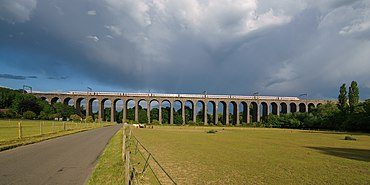Digswell Viaduct

The Digswell Viaduct, also called Welwyn Viaduct, is a railway viaduct that carries the East Coast Main Line over the River Mimram in the county of Hertfordshire in England. A prominent local landmark, it is located between Welwyn Garden City and Digswell. It is just to the south of Welwyn North railway station.
The viaduct, of 40 arches, is a Grade II* listed structure. It was the longest and tallest viaduct on the Great Northern Railway's route.[1][2]
The viaduct is around 1,560 feet (475 m) long and comprises forty arches of 30 ft (9 m) span, and it is 100 ft (30 m) high from ground level to trackbed.[3] It is built of red brick fired from clay quarried on site during construction, and took two years to build, including the construction of embankments at both ends which required the movement of around one million tons of earth by human and horse power. It was designed by William Cubitt and styled after a Roman aqueduct.
It has been claimed that it was officially opened by Queen Victoria on 6 August 1850, but she was reportedly so frightened of its height that she refused to travel across it and left the train, using a horse-drawn carriage to travel the length of the bridge on the ground. However, her published diaries for that day show that she was staying at Osborne House on the Isle of Wight at the time.[4]
The viaduct carries the East Coast Main Line, which has to narrow from four tracks to two to cross the viaduct, making it a bottleneck restraining capacity over this strategic transport route.[5] This problem is exacerbated by Welwyn North railway station situated at the northern end of the viaduct, which blocks the line while trains are stationary, and by two tunnels to the north. Several ideas to overcome the limitations of the viaduct and station without damaging the viaduct's essential historic character and rhythmic design are periodically discussed.[6]
A three-year project in the mid 1930s encased the viaduct's deteriorating brickwork in the blue engineering brick seen today. Overhead lines were added when the line was electrified in the 1970s.[7]
References
[edit]- ^ "Welwyn Hatfield District Plan 2005 Appendix 2: Listed Buildings". Welwyn Hatfield. 2005. Archived from the original on 4 March 2016. Retrieved 2 February 2014.
- ^ Historic England. "The Welwyn Viaduct (1348122)". National Heritage List for England. Retrieved 11 January 2019.
- ^ The Railway Viaduct. Digswell. Hertfordshire Genealogy.
- ^ "Queen Victoria's Journals".
- ^ "APPENDIX 2: Issues in defining and measuring railway capacity" (PDF). Office of Rail Regulation. 13 February 2006. p. 2. Retrieved 28 February 2014.
- ^ "RailEnable: Bypassing the Welwyn bottleneck".
- ^ British Railways Board. "Your New Electric Railway: The Great Northern Suburban Electrification" (PDF). Retrieved 15 April 2010.
External links
[edit]51°49′06″N 0°11′41″W / 51.81833°N 0.19472°W
